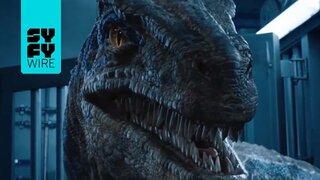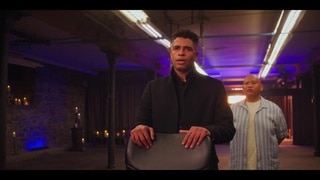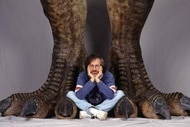Create a free profile to get unlimited access to exclusive videos, sweepstakes, and more!
What Ate the Boat Crew at the Beginning of Jurassic Park III?
We've got a couple of scaly suspects.
The events of The Lost World: Jurassic Park revealed to the world the existence of Isla Sorna and InGen’s previously secret Site B. Four years later, at the beginning of Jurassic Park III (streaming now on Peacock), the island had been cordoned off and any contact with the dinosaurs prohibited. A small tourist operation called Dino-Saur, offers a view of the island from an ostensibly safe distance, strapping paying adventurers to a parasail where they can hopefully see a few dinosaurs lumbering through the jungle without ever stepping foot on Isla Sorna.
The movie opens there, with a couple of tourists (one adult and one kid) taking to the skies off the coast of dinosaur island. After a few minutes, the small boat towing their parasail hits choppy water and slips beneath thick cloud cover. From their vantage point above the clouds, all we can see is the tow rope leading into the mist. Suddenly, something starts yanking on the parasail, jerking the duo up and down violently. When the boat reemerges, its canopy is shredded, and the crew gone.
With the boat cruising directly toward a patch of jagged rocks, the duo cut loose and use their remaining momentum to reach land, taking their chances on the island. It’s the inciting incident that leads Dr. Grant (Sam Neill) to his second dinosaurian misadventure, but it is never explained. The deaths of the two men on the Dino-Saur boat remain a mystery, but we have suspects.
For More on Dinosaurs:
Reconstructing the Voices of Dinosaurs: The Science Behind Jurassic Park III
How Smart Were Rexy and her Tyrannosaur Friends? Scientists Disagree
We're Celebrating the Dinosaur Bicentennial in 2024
Did Spinosaurus Eat the Boat Crew in Jurassic Park III?
Once Grant realizes his clients intend to land on the island, he attempts to stop them. Instead, he gets knocked out with a single well-aimed punch and wakes to find himself in dinosaur territory. Almost as soon as they land, the party is attacked by a gigantic carnivore with a tell-tale sail along its back.
Spinosaurus, the movie’s primary antagonist, lived between 99 and 93.5 million years ago, during the Cretaceous, in what is now north Africa. It was a staggering beast weighing as much as 16,000 pounds and measuring 45 feet long. It was the largest known carnivorous dinosaur in terms of total size, but its relatively stubby legs would have made it shorter than T. rex and other large theropods when standing.
In the film, we see the Spinosaurus racing across land, smashing through decaying fences, and gliding through the water. It’s seemingly as comfortable in aquatic environments as it is in terrestrial ones. We know from the shape of its teeth and jaw that Spinosaurus ate fish, but it may have fed on other dinosaurs as well.
Its characteristic sail, running the length of its back, probably helped with regulating body temperature as well as navigating through the water with the help of a paddle-like tail. It also featured a long, narrow snout similar to a modern crocodile and nostrils set high up by the eyes. Considering how aggressively the Spinosaurus attacks every other human who sets foot on the island and its unique set of evolutionary characteristics, it’s a solid contender for the movie’s unseen attacker.
Did Pteranodons Eat the Boat Crew in Jurassic Park III?
Pteranodons, like other pterosaurs, weren’t true dinosaurs. Instead, they were a group of flying reptiles which lived alongside dinosaurs. The smallest pterosaur, Nemicolopterus, had a wingspan of just 10 inches, while the largest, Quetzalcoatlus, were about the size of a flying giraffe.
Pteranodons were toward the larger end of the flying reptile spectrum and they, like Spinosaurus, lived during the Cretaceous, between 100 and 90 million years ago. Unlike Spinosaurus, Pteranodons filled the skies over modern-day North America.
Full grown, Pteranodon sported a 23-foot wingspan, and a long pelican-like jaw. Those large wingspans supported relatively small, lightweight bodies. Their bones are almost entirely hollow, with walls about a millimeter thick. Atop their heads you’ll find large eyes for seeking out prey from on high and large crests which were probably used for identification and steering in flight. Fossilized fish bones found in their guts confirm that Pteranodons were aquatic hunters, possibly skimming the water in flight or diving like some modern birds.
When Dr. Grant and company are seeking out a boat as a possible means of escape, they cross a fog-shrouded bridge and find themselves inside an aviary filled with pteranodons. Later, when rescue finally arrives, we see them flying away from the island for parts unknown. An earlier version of the script featured a subplot involving mysterious deaths on a nearby inhabited island. Those deaths would have been revealed to have been the work of escaped Pteranodons. By the time Jurassic Park III went to production, the Pteranodon murder spree had been reduced to just one anonymous killing at the movie’s beginning. Allegedly.
Examine the evidence yourself in Jurassic Park III, streaming now on Peacock.




















